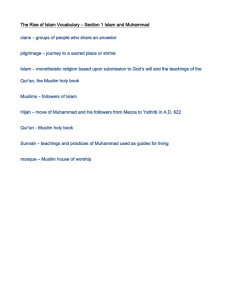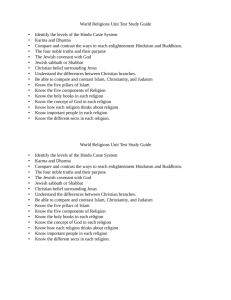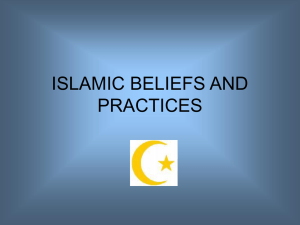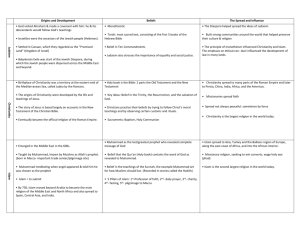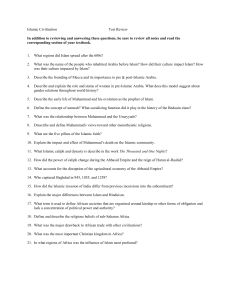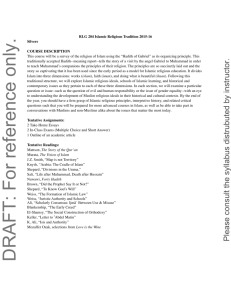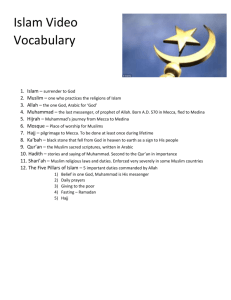Judaism, Christianity, And Islam
advertisement
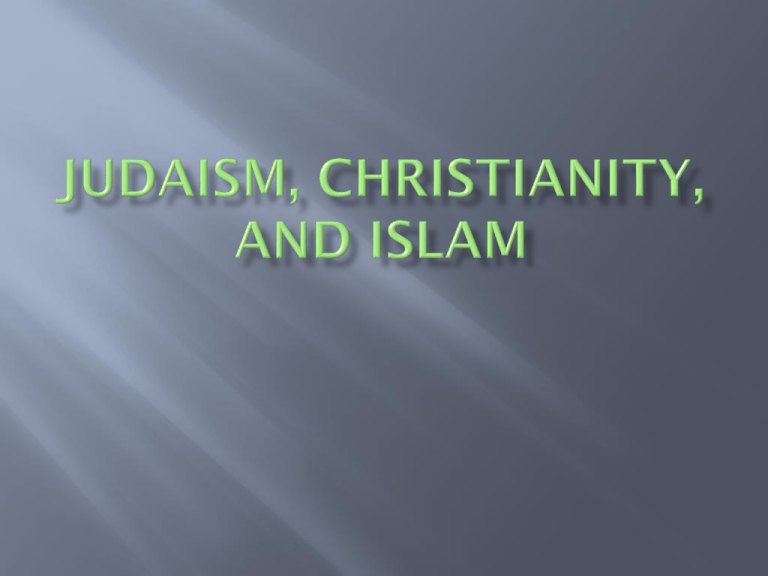
Rebus – A riddle composed of symbols suggesting the sounds they represent Basilica – A roman law court; converted to an early form of Christian church buildings Hymn – A song of praise to God Melismatic Style – Multiple notes given to individual syllables Canon – Authoritative list of written works Diatribe – literary form in which the speaker raises a series of questions and answers them Judaism originates in Mesopotamia A religious and national entity Descended from Abraham The word Hebrew is a reference to Abraham His descendants would eventually be known as Israelites after Abraham’s grandson Israel The Jewish faith wouldn’t be called Judaism until well after the Hebrew nation was split into the Northern and Southern Kingdoms Consists of a belief in one almighty God who has chosen the Hebrews as His people Initially, the Hebrews were a seminomadic people During the 14th century BCE the Hebrews were enslaved in Ancient Egypt During this time they were liberated by Moses who led them out of Egypt Moses became the greatest of Hebrew prophets He used the power of God to free his people from Egypt, received the Ten Commandments, and led them to the promised land Fifteen Commandments After wandering through the desert for forty years, the Hebrews conquered the land of Canaan Under the leadership of Joshua, the nation of Israel became a stable political and religious entity The nation flourished under King David and conquered the city of Jerusalem which became its capitol King Solomon built a great Temple in Jerusalem which became the religious center of Israel After the death of Solomon, a power struggle ensued and divided Israel into two kingdoms The Northern Kingdom - Samaria The Southern Kingdom – Judah Judaism refers to the Southern Kingdom of Judah Both kingdoms would eventually fall leaving Israel in ruins The destruction of Solomon’s Temple in Jerusalem left the Israelites without a central place of worship It was rebuilt in 515 BCE but was destroyed again after Roman conquest in 70 CE Monotheistic Based on a series of covenants (agreements) between God and mankind Believed in one god God will bless the people if they worship Him and observe His laws Centered on the Hebrew Bible (The Old Testament/the Torah) Not only consisted of a set of religious beliefs, but a common genealogy as well All Hebrews are descendants of Abraham Originates in the 1st century CE Based on the teachings of Jesus Christ What is known of Jesus’ teachings comes from the Gospels of the New Testament Believed that Christ was the fulfillment of the Jewish prophecy of a Messiah (anointed one) These were written several decades after the death of Christ Jesus preached about a God who especially loved the downtrodden and outcast Christ’s teachings were revolutionary in the Roman Empire He was executed by Pontious Pilate through crucifixion Crucifixion was a common manner of Roman execution The Gospels say that on the third day he arose from the dead This constitutes the miracle on which Christianity is based – God’s redeeming act of salvation The spread of Christianity comes from the Apostolic Mission Christ told his disciples to make disciples of all the nations Belief in Christianity spread quickly due to its accessibility and message of redemption Christianity spread throughout the Roman Empire with some resistance Christians were persecuted for not worshiping the emperor as a divine entity Christians would continue to be persecuted and seen as outsiders until the time of Emperor Constantine Constantine had a dream in which he won a military battle by placing Christian symbols on his army’s uniforms He won the battle and converted to Christianity Constantine’s conversion made Christianity the official religion of the newly named Holy Roman Empire Monotheistic Centers on the teachings of Jesus Christ, belief in his resurrection Belief in the same God of the Hebrews Jesus was God’s way of saving all of mankind Focuses on the New Testament Collection of the four Gospels, other writings on church history, epistles (letters), and the apocalypse Jewish Little Jewish painting exists due to the 2nd of the Ten Commandments What does exist is in the form of decoration These decorations record the history of the Hebrews in pictures The images show a real concern with plasticity (three-dimensional space) Humans and animals appear shaded and detailed in such a way that gives form to the images Christian Early Christian painting appears in the catacombs of Rome Roman influence is seen in the separation of images into compartments Christian Initially Christians used secretive symbols that only they could understand One of the earliest Christian symbols is the Chi-Rho This symbol combines two Greek letters (XP) These letters are the first two letters that appear in the word Christos (Christ) Other Christian symbols included the ichthus (fish) and the lamb The lamb was meant to represent Christ The spread of Christianity in Rome also led to the decoration of Roman sarcophagi with Christian imagery The sarcophagus of Junius Bassus is an early example of a Christian sarcophagus It depicts multiple stories from the Old and New Testaments Jewish The Temple in Jerusalem was the center of the Jewish faith The structure housed the Ark of the Covenant The Ark of the Covenant held the shattered pieces of the Ten Commandments Christian Early Christian architecture adapted the existing Roman style The first churches were converted from the Roman basilicas Christians removed the many entrances of the Roman basilica and designed the building to focus attention on the altar Jewish References to music are made constantly throughout the Hebrew Bible Even King David was known for his ability to play the lyre Christian Early Christian music combined elements of Jewish worship songs and Greek/Roman Classical forms Most instrumental music was frowned upon in services Vocal music was the preferred style Christian cont. In the 4th century hymns emerged Early hymns consisted of poetic texts with multiple verses that used the same melody These were intended to be sung by the congregation rather than a formal choir The alleluia also developed during the 4th century The alleluia is known for its use of melismatic style Jewish The Hebrew Bible contains three sections that have been accepted as canon The Law (Torah) – Contains the Ten Commandments and the books of Genesis, Exodus, Leviticus, Numbers and Deuteronomy The Prophets – Tells the history of Israel and Judah The Writings – Contains a variety of literary forms such as poetry and apocalyptic visions Christian The Christian Bible became the most significant literature of its time The primary canon for the Christian Bible lies in the New Testament which contains four literary forms The Gospels (Good news) – Tell the life and teachings of Jesus Christ History – Contained in Acts, tells about the spread of Christianity Epistles (letters) – Letters written to various churches and individuals Utilized diatribes Apocalypse – The Book of Revelation (God’s plans for the end of days) Mosaic – A decorative work for walls, vaults, floors, or ceilings, composed of pieces of colored material set in plaster or cement Hajj – A Muslim’s sacred pilgrimage to Mecca Mosque – Muslim place of worship Framing Tale – Overall unifying story within which one or more tales are related Islam emerged out of the Arabian peninsula Islam is centered on the teachings of Muhammad Many people were suffering in Mecca when Muhammad began preaching Muhammad taught that all must make Islam (to submit) to the one God His teachings are contained in the Qur’an (Islamic holy book) After Muhammad’s death, Islamic leaders encouraged jihad (holy struggle) to expand the influence of the faith The appeal of Islam rested in its openness to everyone Islam stressed the brotherhood of the faithful rather than race or culture During the Middle Ages the Muslims became known for excelling in math and science Also produced proficient artists, writers, and architects Islam believes in the one God, Allah Muslims believe that God wants people to repent and purify themselves to attain Paradise after death God communicates through the prophets which include Abraham, Moses, Jesus, and Muhammad Muhammad is respected, but not worshipped Islam teaches faith in God, kindness, honesty, industry, courage, and generosity Islam requires all believers to perform five religious duties known as the Five Pillars of Islam Pillar 1: Believers must recite the shaddah (There is no god but God and Muhammad is his prophet) Pillar 2: Ritual prayers facing Mecca must be performed five times a day Pillar 3: Fast during the holy month of Ramadan Pillar 4: Pay zalaat (a set percentage of each adult’s wealth to help the poor) Pillar 5: If possible, at least once perform hajj (pilgrimage to Mecca) Islam Typically images of living things are prohibited by Muslims However, existing images were considered harmless if they did not cast a shadow, were small, or were on everyday objects Early Islamic illustrations accompanied the translation of Greek scientific manuscripts Arab traders brought a Chinese influence into Middle Eastern art In the 14th century paintings about the life of Muhammad were common The Ascension of Muhammad tells a story from the Qur’an The angels and centaur Muhammad rides have oriental faces Scripture in Arabic also accompanies the art Vivid colors and elaborate figures create a framework around the Prophet The first major example of Islamic architecture appeared in 691 The Dome of the Rock was built near the site of the Temple of Solomon Was designed to be a special holy place, not just a mosque The site is said to be the tomb of Adam, where Abraham prepared to sacrifice Isaac, and where Muhammad ascended into heaven Decorated with glazed blue tiles on the exterior Inside, mosaics made out of gold, glass, and mother-of-pearl decorate the walls and floors Mosaics are made up of multi-colored tiles that form an image Most early Islamic architecture features decorative mosaics that depict everyday objects Later Islamic architecture would feature minarets (towers) From the minarets Muslims would be called to prayer by the muezzins (prayer leaders) Music has fallen in and out of favor with Muslims over the span of many generations Islamic music primarily functioned as part of religious rituals Sometimes verses of the Qur’an would be chanted as hymns Music also accompanies the chanting of the name of God in worship services One of the most well known pieces of Islamic literature is The Thousand and One Nights or The Arabian Nights A collection of stories accumulated during the Middle Ages Utilizes a framing tale to unify the mass of smaller stories Includes such stories as “Ali Baba and the Forty Thieves” and “Aladdin and the Magic Lamp” The stories are supernatural, romantic, and satiric at times The Qur’an is the sacred scripture of Islam For Muslims, the Qur’an forms the ultimate source of knowledge and inspiration for life Consists of 114 surahs (chapters) arranged in length from longest to shortest The entire Qur’an is shorter than the New Testament The Qur’an is written in Kufic script A style of calligraphy developed to give the Qur’an the proper honor
